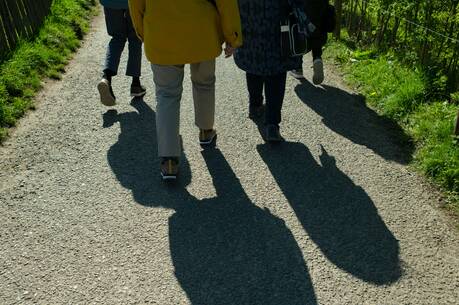Rough Ways Made Smooth
In some cultures, a woman who has been widowed or who loses a child wears black for a year or more, signaling her mourning. Her face, too, wears the marks of grief. The sparkle in her eyes gives way to ready tears and her gait becomes heavy from sorrow. Such is the image of the city of Jerusalem in today’s first reading.
Baruch, a disciple of Jeremiah, characterizes the devastated city as a woman in mourning for her exiled children, who have been forcibly taken away from her. The prophet declares that it is now time for Jerusalem to exchange her robe of mourning and misery for a brilliant new mantle. Her new cloak is spun from justice and glory from God. If she despaired for her children, thinking God had forgotten them, the prophet insists that “they are remembered by God.”
The humiliation of their forced march into exile on foot will be undone by their being carried back aloft, as if they were royalty. The heights of despair and the depths of depression will be leveled out. It is not that the suffering is forgotten, or that anything could go back to being the way it was before the tragedy, but now the divine gift of joy settles over the grieving mother as rebuilding life out of the ruins begins. The returnees are led by God’s light, and their companions are mercy and justice.
Divine mercy embodies God’s motherly care, as she grieves with all who mourn and acts with compassion to bring relief for all who suffer. Divine justice is the setting aright of all relationships: with God, self, others and the whole of the cosmos. With these two companions come healing, restoration and the chance for a new beginning.
In the Gospel, there is a similar invitation to a new beginning announced by John the Baptist. The narrative starts on an ominous note, as John’s ministry is set against the backdrop of the Roman imperial rulers. By listing Tiberius Caesar, the emperor; Pontius Pilate, the governor; Herod, Philip and Lysanias, the tetrarchs; and, finally, Annas and Caiaphas, the high priests who colluded with the Roman authorities, Luke is not simply displaying an interest in history. He is reminding his hearers of the omnipresent imperial power that kept the inhabitants of Palestine in fear and grief at many levels. He foreshadows the terror of John’s execution and of Jesus’ crucifixion by introducing Herod and Pilate before these two prophets have even spoken their opening words.
Luke’s hearers already know the end of the story. It is in this context that we hear John’s invitation not only to turn away from personal choices that impede God’s coming, but also to collective repentance and a turn toward divine mercy. Any desire for revenge, any attempts to try to retaliate with violence must give way to forgiveness on the part of the victims. This forgiveness invites repentance on the part of the offenders. Using Isaiah’s words, John first speaks in imperatives: prepare and make straight the way. But then the verbs shift to the passive voice, implying that it will be the coming one himself who will do the filling in of the valleys and leveling of the mountains, straightening out winding roads and smoothing the rough ways.
For them and for us, his coming does not eliminate these challenges along life’s path but fills us with saving joy, justice, forgiveness and mercy as we open ourselves to the great things God has done and continues to do for us.
This article also appeared in print, under the headline “Rough Ways Made Smooth,” in the November 30, 2009, issue.







